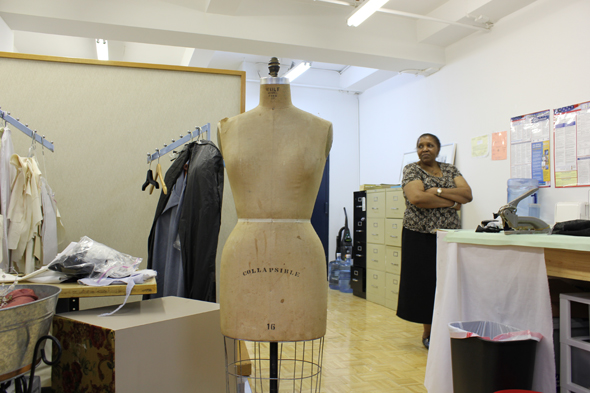
If you are being strangled you can still breathe: This is what Patricia Harper tells herself as she struggles to keep her dressmaking business alive, with only about three private commissions to carry her through each month, no assistants and a tight budget. It’s a struggle for her to balance the books when she can never think more than a few garments ahead with her costs rising, as her rent increases and the high price of quality fabric, which she sources from Manhattan for the garments she produces.
Her studio, Harper Atelier of New York, is the product of her love for fashion and her adoration of her 26-year-old daughter Nicole, a tall, slender young woman, whom Harper says keeps her going one stitch at a time, despite a volatile economic climate that makes the 63-year-old designer wonder if it’s finally time to turn off her Singer, pack up and leave.
She migrated to New York City in 1979 with a dream of creating beautiful clothes, and two years later enrolled at the Fashion Institute of Technology. When she was 37, she gave birth to her daughter while she was still a student, and then worked as a patternmaker for a string of designers including Heidi Wiesel and John Anthony in the Garment District of Manhattan. She now makes her own one-of-a-kind formal gowns that sell in the $3,000 to $7,000 price range.
Harper, a tall, Venezuelan woman who carries herself with dignity, wears an embroidered caftan over a long black skirt that stops just above a pair of black boyish oxfords, as she reminisces about a time when the streets around her studio were filled with promise.
“The only thing I see when I came to USA, people pushing carts in the street, you could find jobs,” she said. But rolling carts filled with new clothes have almost disappeared from the streets, along with the billowing steam from clothing presses that once poured out of factory windows. Clothes that were once produced in Manhattan are now made overseas, and with such small orders, offshore production is simply not an option.
Prior to owning her own line, Patricia also worked for couture designer Mary McFadden. Harper’s daughter Nicole spent most of her adolescence visiting her mother at McFadden’s store in the Garment District, but she doesn’t see she too many changes between those years and when she visits the neighborhood today.
“I didn’t understand or see a lot of changes that were made within the 10 years I was going back and forth because it was like a time capsule I was living in,” Nicole said. “The only thing I really noticed while I was there was some of the head people left, mainly because people that worked there were much older and left because they were retiring.”
It wasn’t until Nicole was in college that Patricia was finally able to realize her dream and move into her very own studio. Just as her mother had been understanding when she didn’t want to pursue fashion, Nicole now had to be understanding as her mother worked tirelessly on her dream.
“I barely saw her when I came home,” Nicole said. “She was always busy, working all the time. Everything was all her — all her mind, all her everything, her sketches, her picking out the fabrics. It was like a whole other entity, like a kid that took her away from me. I was a little jealous, but it was something she needed to do, so I supported her.”
Christine Helm, the coordinator at the Enterprise Center at the Fashion Institute of Technology, says that new opportunities are in fact emerging today, particularly for small businesses in the area, even though Patricia Harper’s atelier resembles a situation far more bleak. “At this moment there are a lot of opportunities beginning to peek in,” Helm said. “There are rising wages in Asia, and with the recession some of the factories in Asia have closed, and designers need to place bigger orders than ever to go offshore.”
In her view, the Garment District is turning a corner. She believes that manufacturing will never disappear from Manhattan, particularly because of the young designers who graduate from institutions like FIT. “There are simply more options to businesses now,” said Helm. “Not only is the Internet established and people are constantly buying online, there are more and more ways to do that now, mobile shopping, Apps.” But technology is not part of Harper’s world: She does not have a website; she does not even have a low-tech storefront display to attract passersby.
Organizations have been set up in the Garment District to help protect designers, but she doesn’t seem to be reaping the benefits in the way that bigger brands do. Made in Midtown, an initiative by Design Trust for Public Space in 2009 in partnership with the Council of Fashion Designers of America, aims to draw attention to the inner workings of the Garment District and highlight the area as a hub for fashion design and production.
Harper says she would readily heed this kind of support, but in reality doesn’t see any of the benefits at play. As far as she knows, organizations like Made in Midtown are non-existent.
Jerome Chou, the Director of Programs at Design Trust for Public Space, said, “The District supports every kind of designer, from people straight out of school to major labels that still do some prototyping and small runs that require quick turnarounds.” But Harper doesn’t see any of the benefits that this initiative offers, at least not in terms of securing her place in the Garment District. The reality for Harper is that the next step for her would be to prematurely retire.
Harper is resilient, even if she occasionally must turn to her daughter, who works in pharmaceuticals, to help her out financially. “To start all over is not an option,” she said. “ I just want to be a success.”